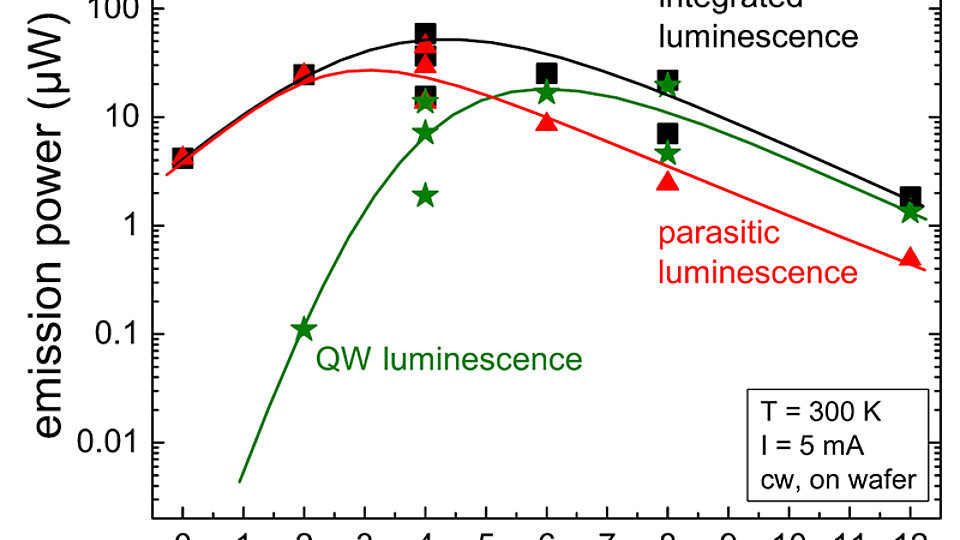UV LEDs with dominant emission at wavelengths <240 nm
Fig. 1: Emission power of UV LEDs with a QW emission wavelength <250 nm in dependence of the thickness of the AlN electron blocking layer, divided in its two dominant spectral components (QW and parasitic, long-wavelength luminescence).
The development of UV LEDs emitting in the ultraviolet (UV) spectral region is currently directed towards devices with an emission wavelength around 265 nm for the use in water disinfection. However, applications such as sensors and charge management of test masses in space missions to detect gravitational waves require UV LEDs with significantly shorter emission wavelengths. Up to now, such devices are not commercially available as it is getting increasingly difficult to suppress long wavelength components in the emission spectrum of deep UV-C LEDs. And it is equally challenging to obtain a reasonable efficiency of such LEDs. These effects are mainly due to the high aluminum mole fraction in the used Mg or Si-doped AlGaN heterostructures preventing an effective charge carrier injection in the quantum films. By using a new heterostructure design and carefully optimizing the corresponding semiconductor structures FBH and TU Berlin have now managed to fabricate UV LEDs with a dominant emission wavelength <240 nm in the framework of their Joint Lab GaN Optoelectronics.
The semiconductor structures are based on lateral epitaxial overgrowth (ELO) of AlN on sapphire and efficient silicon doping of AlGaN with high aluminum mole fraction – both are processes well established at FBH and TU Berlin. One main result of the development was that the parasitic long-wavelength component in the emission spectrum sensitively depends on the design of the Mg-doped AlN/AlGaN heterostructure. This structure is inserted directly above the quantum films to suppress the undesired overflow of electrons from the p- to the n-side of the diode. Using a novel electron blocking heterostructure design and an optimized AlN interlayer both leads to efficient carrier injection in the quantum films and minimizes carrier recombination at point defects at the interfaces above the quantum films (compare Fig. 1). The spectra of UV LEDs fabricated from structures optimized in this manner show a dominant peak at 234 nm which accounts for almost 90% of the total emission power. The maximum optical power and external quantum efficiency of the UV LEDs are 25 µW and 0.012%, respectively, which is already sufficient for many applications (compare Fig. 2).
Publication:
F. Mehnke, C. Kuhn, M. Guttmann, C. Reich, T. Kolbe, V. Kueller, A. Knauer, M. Lapeyrade, S. Einfeldt, J. Rass, T. Wernicke, M. Weyers, and M. Kneissl, "Efficient charge carrier injection into sub-250nm AlGaN multiple quantum well light emitting diodes", Appl. Phys. Lett., vol. 105, no. 051113 (2014).
FBH research: 23.09.2014

